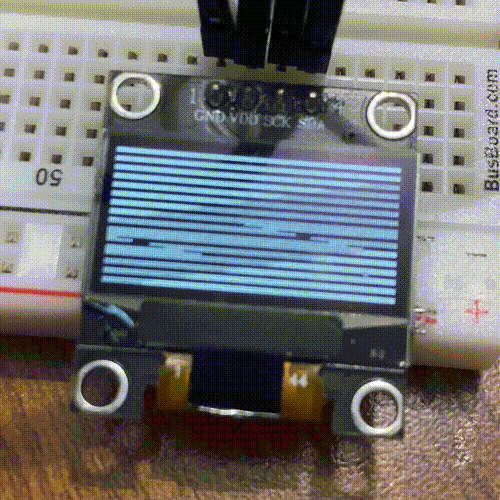Bit Bang SPI with Ruby+YJIT
In my previous post, I tested Ruby+YJIT against C, doing bit-bang I2C in the lgpio gem. The results convinced me to just do bit-bang SPI in Ruby.
Testing YJIT vs. plain Ruby for this is trivial, but can I compare against C, without actually writing a C implementation? SPI is almost the same as I2C for the purpose of my OLED benchmark. Could I use the I2C results somehow? We’ll get to that, but first…
Improving I2C
Since the last post, I made an optimization to I2C: save the SDA pin state, and only call the C API when it needs to change, so fewer calls overall.
For fairness, I did this for both implementations, and changed the C and Ruby benchmarks to use a pattern of lines. This makes it so approximately half the time SDA needs to change, and the other half, it stays. It looks like this now:

Of course, I had to redo all the benchmarks. These are the results in short:
Frames per second. Best 3 of 10 runs averaged. Higher is better.
C implementation : 45.00 fps | 1070k C calls/s
C implementation + YJIT : 45.24 fps | 1076k C calls/s
Ruby implementation : 29.01 fps | 690k C calls/s
Ruby implementation + YJIT : 40.71 fps | 968k C calls/scc
Ruby+YJIT vs Best C : 90.0%
% Gain From YJIT : 40.3%
Everything is faster. Ruby+YJIT as a percentage of C is about the same. YJIT is doing more vs. plain Ruby, maybe because it’s constantly using the saved SDA state. I put this data pin optimization into bit-bang SPI from the start too, so it’s an even playing field.
You’ll notice I calculated the number of C calls (lgGpioWrite or lgGpioRead) per second.
I’ll spare you the explanation, but with this pattern, I2C now makes 23 calls for 99% of bytes, and up to 28 for 1%. SPI does 20 and 24 respectively. 1% is negligible, so I2C is 23, SPI is 20.
Why Do We Care?
This example in the LGPIO C repo benchmarks how many times lgGpioWrite can be called per second, doing nothing else. It prints “toggles per second”, so double the result to get calls. I modified it to call lgGpioRead instead, and results were basically the same.
My Pi 4 setup averages 1111k C calls per second. This is the new high-water mark.
We can compare the different I2C implementations against this, to estimate how much time is spent on things that aren’t GPIO calls:
GPIO throughput loss (overhead) vs. pure C toggling. Lower is better.
C implementation : 3.7 %
C implementation + YJIT : 3.2 %
Ruby implementation : 37.9 %
Ruby implementation + YJIT : 12.9 %
YJIT looks even better now. The Ruby it can optimize runs at almost 3x speed!
Back to SPI
I wrote this benchmark, where the SPI interface sends out a pattern of bytes almost exactly like it’s driving an I2C OLED, except for 1179 pixel bytes instead of 1024. Ignoring the 1% of bytes with slight variance, 1179 makes it the same number of C calls per “frame” as the real OLED.
Note: This won’t drive the SPI version of the SSD1306. It’s just a simulation for comparison.
Before the results, also note that SPI has to do more than I2C:
- Every transfer first checks the mode to set the right idle clock level
- Every byte can branch to be either MSBFIRST or LSBFIRST
- Every bit uses a
casefor SPI mode, so GPIO levels change in the right order - Every bit has two more conditionals, since reading and writing can both be optional
All of this happens in Ruby, so YJIT should help more than it does with I2C.
Results
Higher is better for fps & calls/s. Lower is better for overhead.
ruby examples/spi_bitbang_ssd1306_sim_bench.rb
# Results: 26.86, 26.39, 26.22 | Average: 26.49 fps | 630k C calls/s | 43.3% overhead
ruby --yjit examples/spi_bitbang_ssd1306_sim_bench.rb
# Results: 42.87, 42.80, 42.07 | Average: 42.58 fps | 1013k C calls/s | 8.8% overhead
Conclusion
- YJIT improves overall performance by 60.7 % over plain Ruby
- Compare to a 40.3% gain for I2C
- Without YJIT, 43.3% of time is spent in Ruby, instead of writing to GPIOs
- YJIT speeds up the Ruby parts by a factor of 4.92x!
- Ruby+YJIT SPI reaches 91.2% of max theoretical GPIO throughput
- Compare to 87.1% for I2C
- Perhaps YJIT handles the SPI control flow or keyword args better?
- Ruby+YJIT’s throughput is 94.2% of a hypothetical C SPI with equal overhead to I2C
- Real C overhead may be a bit more, as mentioned above, favoring YJIT
I don’t feel the need to write it for real and find out. Maintaining Ruby instead of C is worth the small performance hit, especially when these are likely to be used at far lower data rates than tested.
